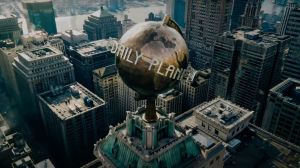World War I is going to be revisited on the big screen in epic fashion when Sam Mendes debuts his 1917 film later this year. Set over the course of about two hours, the movie will take place in one continuous shot, sprawling across locations and through action sequences. The viewer will never be taken out of the scene as the the production crew and editing team will be doing their best to innovate their efforts and portray the entire film as one continuous, two-hour shot which is put together in real time. Of course, the film took several months to shoot and cameras do cut several times, but Mendes and his cinematographer Roger Deakins found a way to portray war like never before.
Videos by ComicBook.com
Deakins, known for his impressive work on titles such as Shawshank Redemption and Skyfall (along with Mendes), was quickly convinced to get on board with the challenging film. “The biggest challenge was to sort of have the camera connected to the characters so it was in the right place to tell the story, to get the right reactions, see the scenes, see the surroundings,” Deakins explained. “So it was like a big dance. It’s always that. Any film you do you’re figuring, ‘Oh, where do we want to play this wide? Do we need to see a reaction? What is the best angle?’ But obviously here all that had to work as one. So it was very much for Sam to stage the action, and us to stage the camera in a sort of balletic way that each complemented the other.”
The entire concept is mindblowing — especially after seeing a featurette at New York Comic Con showcasing the size of the production. One shot, specifically, called for 500 extras in addition to explosions and countless moving parts which will be integrated into the film’s single take perspective.
While the style of shooting was new to the production team, sometimes calling for single takes which require more than 8-minutes of perfection from a camera crew through a talented cast, it was something new for those in front of the camera as well. 1917 will be putting its lead actors Dean-Charles Chapman (Game of Thrones) and George MacKay (Captain Fantastic) at the forefront, accompanied by some well-known veterans such as Benedict Cumberbatch (Doctor Strange), Colin Firth (Kingsman), Mark Strong (Kingsman), and Richard Madden (Game of Thrones). Across the board, there was some additional effort required to pull off the single-shot effect.
“It was interesting actually, because you did have people like Colin Firth, Benedict Cumberbatch and Andrew Scott, kind of nervous,” Mendes recalls. “They couldn’t do that five, six, seven, eight minute take in the series of close ups or coverage. You can work on it in little bits, you have to get it all right in one take. And I know that sounds, kind of obvious in a way but, when you’ve done, you’ve got a six minute take, let’s say and you make a mistake in the last three seconds of the take so you have five minute, 55 seconds perfect take. And then the last moment, you blow, you have to start again. And so, it is kind of like a nightmare. And now I respect when you said, ‘It sounds like a nightmare.’ There were times when I thought, ‘You know, no please no, right at the end something went wrong.’ But the exhilaration and the feeling when you get it right, and the feeling when you’ve got it, it’s so, it’s such a high. It’s a kind of drug. You wanna do it again. And we fed off that excitement, and that energy all the way through. So that’s what got us through on it.”
Mendes was straightforward with his cast and crew on 1917 about his single-shot perspective of the film — so much so that it was stamped on the front of their scripts. “I actually wrote it on the front page of the script,” Mendes said. “I said, ‘This is going to be one shot. So it’s kind of like saying, ‘If you don’t wanna do a one shot movie, don’t do that, don’t open the script.’ But when you read the script, It makes sense, I think. It’s two hours of real time. It’s two guys following them through the, destroyed landscape of World War I in 1917. It goes through so many different locations, so many different places, so many different emotional states. And it’s what happens to these boys on their journey. So, it makes sense when you read it. Then in terms of actually achieving it, it is incredibly complicated. But we had a long time to do it. And I had, you know, the greatest living cinematographer by my side. I’m just the one to deconstruct so you know.”
Are you looking forward to 1917? Stay tuned for more from ComicBook.com’s interviews with the cast and director at New York Comic Con. Leave your questions in the comment section or send them my way on Instagram or Twitter!
1917 is in select theaters on December 25, 2019 and gets a wider release on January 10, 2020.









